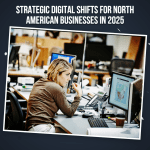Small and medium sized enterprises in North America operate in a marketplace that is both increasingly competitive and filled with opportunity. The ability to adapt marketing strategies to changing consumer behavior, technological innovation, and community expectations has become a defining factor for long term growth. While large corporations traditionally held advantages in resources and reach, the digital transformation of recent years has leveled the playing field. Today, small business leaders have access to data driven, highly effective marketing tools that can create measurable impact.
The following ten strategies provide an authoritative framework for business owners who seek to enhance engagement, expand reach, and build resilient brands. Each approach is supported by evidence of its effectiveness and grounded in the practical realities of North American markets.
Short Form Video as a Dominant Medium
The rise of short form video has altered the way brands communicate. Platforms such as TikTok, Instagram Reels, and YouTube Shorts have established themselves as primary venues for consumer attention. These videos succeed because they are concise, engaging, and designed for rapid consumption.
Small business leaders can capitalize on this medium by producing content that is authentic and relatable. A bakery in Winnipeg can generate demand with a simple tutorial on cake decoration, while a fitness studio in Chicago may highlight a new class with a 20 second demonstration. Research consistently indicates that audiences respond more strongly to content that feels genuine rather than heavily produced. This democratization of video marketing allows small businesses to compete directly with larger organizations at relatively low cost.
Optimized Local Profiles as Trust Builders
Local visibility is often the foundation of small business success. Optimizing digital profiles on platforms such as Google Business Profile or securing a .CA domain in Canada provides credibility and improves search visibility.
The data is clear. Studies show that more than 85 percent of Canadian consumers prefer businesses with .CA domains, associating them with trust and local commitment. Similarly, U.S. consumers rely heavily on verified profiles, accurate information, and updated images when making purchasing decisions. For small businesses, these profiles function as digital storefronts, setting the tone for consumer expectations before the first point of contact. Regular updates, verified details, and proactive management of reviews enhance both credibility and visibility.
User Generated Content as a Multiplier
Consumers today place greater value on peer generated content than traditional advertising. Encouraging customers to produce reviews, images, and testimonials effectively scales trust and visibility without substantial advertising spend.
Practical applications include contests that incentivize customer participation, in store photo opportunities, and featuring client stories on official websites and social media platforms. When managed correctly, user generated content functions as digital word of mouth. It both reduces the cost of acquisition and strengthens authenticity, which is increasingly critical in a crowded digital environment.
AI Tools for Precision and Personalization
Artificial intelligence has transformed the economics of marketing. Where once advanced analytics and personalization required enterprise level budgets, today small businesses can deploy AI to execute tasks with precision and efficiency.
Applications range from automated customer segmentation to predictive sales analysis. An Ottawa florist, for example, may use AI to send personalized reminders for anniversaries or holidays. A U.S. retailer might analyze customer behavior to recommend targeted promotions. The outcome is measurable: higher engagement, improved conversion, and the ability to compete with larger firms that previously dominated through scale. AI effectively democratizes advanced marketing techniques, allowing small businesses to pursue data driven strategies without prohibitive cost.
Micro Influencer Collaborations for Authentic Reach
Influencer marketing has shifted from large scale endorsements to micro influencer partnerships. These individuals, often with follower counts between 500 and 10,000, provide localized, high trust engagement.
The return on investment is significant. A Calgary brewery collaborating with a local food blogger achieves both credibility and reach within a specific demographic. A Toronto retailer working with a neighborhood lifestyle influencer gains access to a highly relevant audience at a fraction of the cost of traditional advertising. Micro influencers thrive on authenticity, and their endorsements resonate strongly because they mirror real community interaction rather than celebrity promotion.
Entertainment Driven Content as Value Creation
Consumers increasingly expect brands to provide content that informs, educates, or entertains. Purely promotional messaging is less effective in an environment where attention is scarce.
Small businesses that develop entertainment driven strategies, such as tutorials, challenges, or day in the life features, create lasting engagement. A Seattle retail shop may increase visibility through a fun challenge campaign, while a Vancouver salon might publish short styling guides. This form of content builds loyalty and increases shareability, ensuring that customers view the business not only as a seller of goods but as a contributor to their lifestyle or interests.
Community Centric Marketing as a Differentiator
Engagement at the community level is a proven method for enhancing trust and loyalty. Sponsorships, local partnerships, and events tie businesses directly to the values and well being of their neighborhoods.
An Edmonton bookstore hosting author readings or a Toronto fitness studio sponsoring a local charity run demonstrates a clear commitment to community. Surveys show that businesses which visibly support local initiatives are more likely to retain customer loyalty during times of economic uncertainty. Strategically, this approach positions small businesses as indispensable parts of the local ecosystem, which is a defensible advantage against external competition.
Multi Platform Engagement as a Resilience Strategy
Consumers no longer follow linear purchase paths. They discover brands on social media, research on websites, and complete purchases in store. Businesses that fail to provide seamless experiences across platforms risk losing customers during this journey.
An Edmonton craft shop, for example, can launch an in store promotion while simultaneously hosting a live stream for online audiences. A U.S. retailer can align email campaigns with Instagram highlights and in store signage. Multi platform engagement is not simply an enhancement but a necessity. It reduces dependence on any single channel and provides resilience in times of market fluctuation.
Subscription Models for Predictable Growth
Recurring revenue provides stability and strengthens long term relationships with customers. Subscription models are increasingly viable across a wide range of industries.
A Calgary coffee shop can provide monthly bean deliveries, a landscaping company in Vancouver can offer seasonal care packages, and a wellness brand in Chicago can introduce exclusive member events. These models improve customer retention, reduce acquisition costs, and allow businesses to forecast revenue with greater accuracy. Predictability of income is particularly valuable for small enterprises managing cash flow challenges.
Personalized Communication as Relationship Capital
The final strategy emphasizes the human connection at the center of business. Personalized communication, enhanced by AI but executed with authenticity, strengthens customer relationships.
Automated chatbots, targeted follow up emails, and product recommendations can be designed to mirror personal interaction. For instance, a Toronto gift shop using AI powered chatbots ensures that customer inquiries are answered promptly and with a tone consistent with brand values. Personalized communication nurtures loyalty, transforming transactions into enduring relationships.
Strategic Implications for Canadian and U.S. Markets
Across Canada and the United States, these strategies demonstrate how small businesses can leverage innovation to level the competitive landscape. In Canada, the emphasis on local identity and the “Buy Canadian” movement aligns strongly with community centric and localized digital strategies. In the United States, the scale and diversity of markets provide fertile ground for influencer partnerships, entertainment driven campaigns, and subscription based models.
In both cases, the adoption of AI and video formats serves as a unifying equalizer. These technologies allow businesses of all sizes to deploy advanced strategies with efficiency, creating opportunities that were once reserved for enterprises with extensive budgets.
The evidence is clear. Small businesses that embrace innovative, data driven, and community aligned strategies position themselves for sustained growth. By focusing on short form video, optimized digital profiles, user generated content, AI, influencer collaborations, entertainment, community engagement, multi platform experiences, subscription models, and personalized communication, small business leaders can ensure their relevance in a rapidly evolving marketplace.
These are not simply trends. They are structural shifts in how marketing operates, and they provide a roadmap for leaders who wish to transform customer interactions into enduring loyalty and predictable growth.









